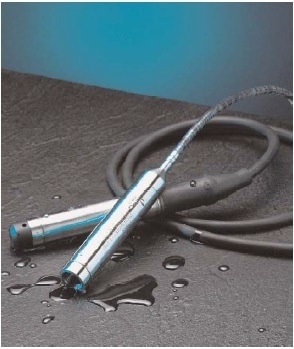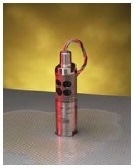“Is this information on the level?” is a commonly asked question, especially in gangster movies. However, the real import of this question is known especially to fluid engineers who needed to measure fluid levels, using floats and a site glass. Today, with advanced technological developments in the field of fluid level sensing, determining the fluid level is much easier.
A very brief introduction to several commonly available methods of evaluating a fluid level is offered below:
Hydrostatic Head Pressure
The fluid level within a tank may be found by assessing the head pressure first, and then using a sensor to convert this signal into an output which directly shows the level. One such type of sensor is based on pressure sensing technology, such as gages and differential pressure transducers. Their advantages include ease of use and installation, with the flexibility to be fitted on to various types of level measurements and other applications within tanks. Such sensors may be mounted on the tank itself or designed to be used as submersible sensors. The difficulty of using this technology arises in situations which demand working with dirty and clogging materials, which leads to the obstruction of small-bore lines and openings, or in corrosive liquids which will break down the sensor over time. Foam and splashing can affect the accuracy of level determination of a flush mounted sensor but not a submersible one, because the latter is within the medium and not at its surface. However, the medium density can affect the precision of the measurements.

Bubbler System
A Bubbler system is another set up which uses compressed gas pumped through submerged tubing connected to a sensor, in order to measure the fluid level. Such systems are ideal when open channel run-off is to be measured. Another situation would be when the level of fluid in a tank or duct is to be determined but foam, surface turbulence, debris or steam makes surface level measurement impractical or impossible by standard hydrostatic sensing techniques.
Ultrasonic Level Sensors
Ultrasonic sensors for fluid level measurements are becoming popular because of their ability to overcome many obstacles to fluid level sensing by other means. They are typically mounted above the tank or process vessel, and transmit a series of ultrasound pulses directed at the surface of the fluid. The time required for each pulse to reach the surface, be reflected off it and return to the sensor, is measured. This is then automatically converted by calculation into the distance from the sensor to the surface, and this output is transmitted as a current loop. The advantage of an ultrasound sensor is its distance (typically several inches) from the surface, so that the media type does not make any difference to the final output. This makes this sensor type useful in sanitary processes where corrosive media must be measured.
However, sensor installation must be done with care because the angle of the ultrasound beam and its range must be so as to excluding other objects capable of reflecting sound, which would vitiate the readings. These false echoes must be avoided. Thus media which splash, foam, or even fog are not suitable for ultrasonic sensors, and a dusty environment is also contraindicated.
Radar Level Sensors
Radar can be used in the same way as ultrasonic sensors, but use microwave radiation of low frequency rather than ultrasound waves, to detect the liquid surface. It is especially suitable for processes which involve liquid levels within the food, pharmaceutical, or beverage industries. The radar waves are much less susceptible to error in environments which contain dust, fog or surfaces which foam, unlike ultrasonic sensors.
Capacitance Sensors
Capacitance sensors detect fluid levels based upon the differences in dielectric properties of air and the liquid medium, the level of which is being determined. The principle is simple: a capacitor is formed by the conductive liquid, the tank wall within which it is contained, and an insulated active electrode. The increase or decrease of the level of the conductive medium causes a corresponding linear variance in the dielectric property of this capacitor. If the medium is non-conductive, on the other hand, a non-insulated metallic rod or cable is used as the electrode.
Insulated concentric sensors have enabled accurate level measurements at various interfaces, even when the medium contains different levels of water, oil or foam. However, a sound understanding of how the tank materials work together and of its grounding for electrostatic safety standard compliance is important for safe and accurate operation, which means a high degree of technical skill is necessary.
Selecting the Right Technology
In order to select the appropriate type of sensor for fluid level sensing, various criteria must be considered, such as:
- The electrical and mechanical properties of the vessel containing the fluid
- The availability of the required length or range of sensing technology within the sensor being considered for the application in question
- Can the sensor be installed as such or does it require a unique mounting apparatus as well?
- Is splashing/foaming/spraying present within the liquid in the vessel? This will not harm the sensitivity or accuracy of submersible sensors, but does reduce the precision of measurement of ultrasonic or radar sensors.
- Does the vessel contain any internal devices or is the environment such as to affect the sensing capabilities, as with ultrasonic sensors?
- What is the critical limit of accuracy of level determination in the given application, and how does it relate to the accuracy of the sensor in question? For instance, when the medium being used is very expensive, accuracy of level measurement is of top priority.
- Are there any specific approvals necessary before the sensor under consideration can be installed, such as capacitance sensors?
- Does the sensing system offer flexibility of adaptation so that users can change the sensing system in future as required, with ease of access to and alteration of electrical interfaces under present and future modes of operation?
- Is there a requirement for additional safety barriers or enclosures to close off specialized equipment (such as control relays) which is part of the electrical installation of the new sensing system?
- Can the sensor be seamlessly incorporated into existing standard fittings? For instance, float level sensors require small connections but the float itself may need a relatively large orifice, necessitating the use of adapters.
General Advice

A large variety of technologies have now become available to enable the level of almost any liquid to be determined with great precision. However, the cost range is also quite wide. Again, as when volatile fluids are to be handled, approvals must be obtained beforehand to ensure a hazard-free environment, as also in the case of sanitary applications. Thus a sensor must be studied carefully and in detail before selection, to ensure that it best fits the installation conditions and working environment.
Finally, a failsafe mechanism is always strongly recommended, rather than relying on one single piece of equipment to ensure safe fluid levels are maintained at all times. This is because using the wrong sensors or sensing system, or choosing low cost over high quality, may prove to be a very expensive mistake in the long run.

This information has been sourced, reviewed and adapted from materials provided by Viatran.
For more information on this source, please visit Viatran.